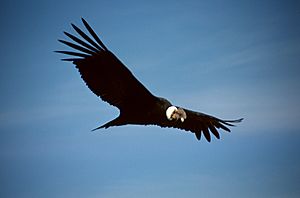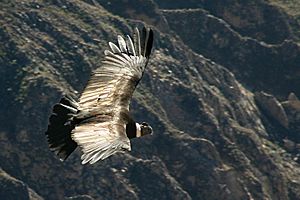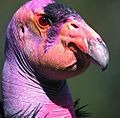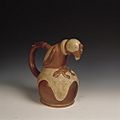Condor facts for kids
Quick facts for kids Condor |
|
|---|---|
 |
|
| Andean condor soars over southern Peru's Colca Canyon | |
| Scientific classification | |
| Kingdom: | |
| Phylum: | |
| Class: | |
| Order: | |
| Family: | |
| Genera | |
|
Vultur |
|
Condors are the common name for two types of very large birds. They are a kind of New World vulture. The name "condor" comes from the Quechua word kuntur. These birds are the biggest flying land birds in the Western Hemisphere.
There are two main types of condors:
- The Andean condor (Vultur gryphus) lives in the Andes mountains of South America.
- The California condor (Gymnogyps californianus) lives in the western coastal mountains of the United States and Mexico. It also lives in the northern desert mountains of Arizona.
| Top - 0-9 A B C D E F G H I J K L M N O P Q R S T U V W X Y Z |
What Makes Condors Unique?
Condors belong to a bird family called Cathartidae. There are also "Old World vultures" which live in other parts of the world. Even though they look similar, New World and Old World vultures are from different bird families. They both eat carrion (dead animals) and have bare heads without feathers. This helps them stay clean when they eat.
How Big Are Condors?
Both condors are very large birds with wide wings. They are excellent at soaring, which means gliding on air currents. The Andean condor is a bit shorter from beak to tail than the California condor. However, the Andean condor has a larger wingspan.
California Condor Size
California condors are the biggest flying land birds in North America. Their wingspan can reach up to 2.9 m (9.5 ft). They can weigh up to 10.4 kg (23 lb).
Andean Condor Size
The Andean condor has one of the largest wingspans of any living flying bird. Its wingspan can be from 274 to 310 cm (8.99 to 10.17 ft). Males are heavier, weighing up to 11 to 15 kg (24 to 33 lb). Females weigh between 7.5 to 11 kg (17 to 24 lb). Their total length can be from 117 to 135 cm (46 to 53 in).
What Do Condors Look Like?
Adult condors are mostly black. They have a ring of white feathers around the base of their neck, like a fluffy collar. They keep these feathers very clean.

Condors have few feathers on their head and neck. This helps keep them clean and healthy. The sun's rays at high altitudes also help to kill germs on their skin. The male condor has a comb or fleshy growth on its head. The skin on their head and neck can change color when they are feeling different emotions. This helps them communicate with other condors.
Their middle toe is very long. Their talons (claws) are quite straight and not very sharp. This means their feet are better for walking than for grabbing prey. Unlike most birds of prey, the female condor is smaller than the male.
Condors from the Past
Scientists have found fossils of condors from the Pleistocene era. These fossils were found in places like New York and Florida. This suggests that ancient condors once lived across North America, not just on the west coast.
Some scientists believe that an ancient relative of the condor, called Argentavis magnificens, was the largest flying bird ever. It lived in South America and might have had a wingspan of 7 metres (23 ft)!
Condor Life and Habits
Condors don't start breeding until they are about 5 or 6 years old. They can live for 50 years or even longer. Once they find a mate, they usually stay together for life. The oldest known condor lived to be 100 years old in a zoo in Algiers!
Raising Young Condors
Young condors are covered in grayish fluff. They stay with their parents until they are about two years old. Even after they learn to fly at six months, they still roost (rest) and hunt with their parents. When a new baby condor arrives, the older young condor moves out on its own.
Condors have a clear social order when they are in groups. They use body language and different sounds to show who is in charge. Even though condors don't have a voice box, they can make many different noises.
Flying and Hunting
Condors are very graceful when they fly. They flap their wings to take off from the ground. But once they are high enough, they mostly glide on air currents. This saves a lot of energy.
Wild condors travel long distances, sometimes up to 250 km (160 mi) in a single day. They are always looking for carrion (dead animals). They prefer large carcasses like deer or cattle. Condors often look for other scavengers, like smaller vultures, to find food. This is because smaller birds can't easily tear through the tough hides of big animals. Condors can go several days without eating. Then, they might eat many kilograms of food at once. Sometimes they eat so much they can't even fly for a while!
Condors in Culture
The ancient Moche people of Peru greatly respected nature. They often showed condors in their art. This shows how important these birds were to their beliefs.
Images for kids
-
Numbered condor in Grand Canyon, Arizona








